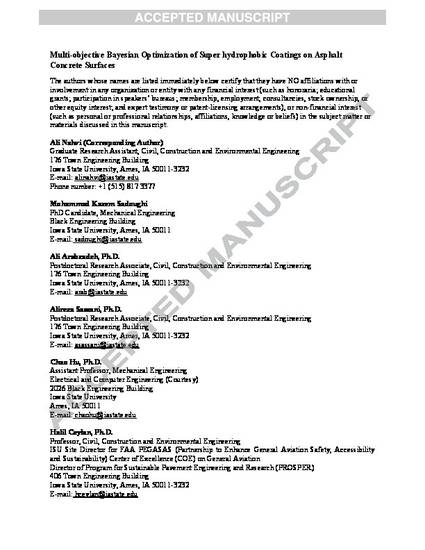
Conventional snow removal strategies add direct and indirect expenses to the economy through profit lost due to passenger delays costs, pavement durability issues, contaminating the water runoff, and so on. The use of superhydrophobic (super-water-repellent) coating methods is an alternative to conventional snow and ice removal practices for alleviating snow removal operations issues. As an integrated experimental and analytical study, this work focused on optimizing superhydrophobicity and skid resistance of hydrophobic coatings on asphalt concrete surfaces. A layer-by-layer (LBL) method was utilized for spray depositing polytetrafluoroethylene (PTFE) on an asphalt concrete at different spray times and variable dosages of PTFE. Water contact angle and coefficient of friction at the microtexture level were measured to evaluate superhydrophobicity and skid resistance of the coated asphalt concrete. The optimum dosage and spray time that maximized hydrophobicity and skid resistance of flexible pavement while minimizing cost were estimated using a multi-objective Bayesian optimization (BO) method that replaced the more costly experimental procedure of pavement testing with a cheap-to-evaluate surrogate model constructed based on kriging. In this method, the surrogate model is iteratively updated with new experimental data measured at proper input settings. The result of proposed optimization method showed that the super water repellency and coefficient of friction were not uniformly increased for all the specimens by increasing spray time and dosage. In addition, use of the proposed multi-objective BO method resulted in hydrophobicity and skid resistance being maximally augmented by approximately 23% PTFE dosage at a spray time of 5.5 s.
Available at: http://works.bepress.com/halil_ceylan/323/

This is a manuscript of an article published as Nahvi, Ali, Mohammad Kazem Sadoughi, Ali Arabzadeh, Alireza Sassani, Chao Hu, Halil Ceylan, and Sunghwan Kim. "Multi-objective Bayesian Optimization of Super hydrophobic Coatings on Asphalt Concrete Surfaces." Journal of Computational Design and Engineering (2018). DOI: 10.1016/j.jcde.2018.11.005. Posted with permission.